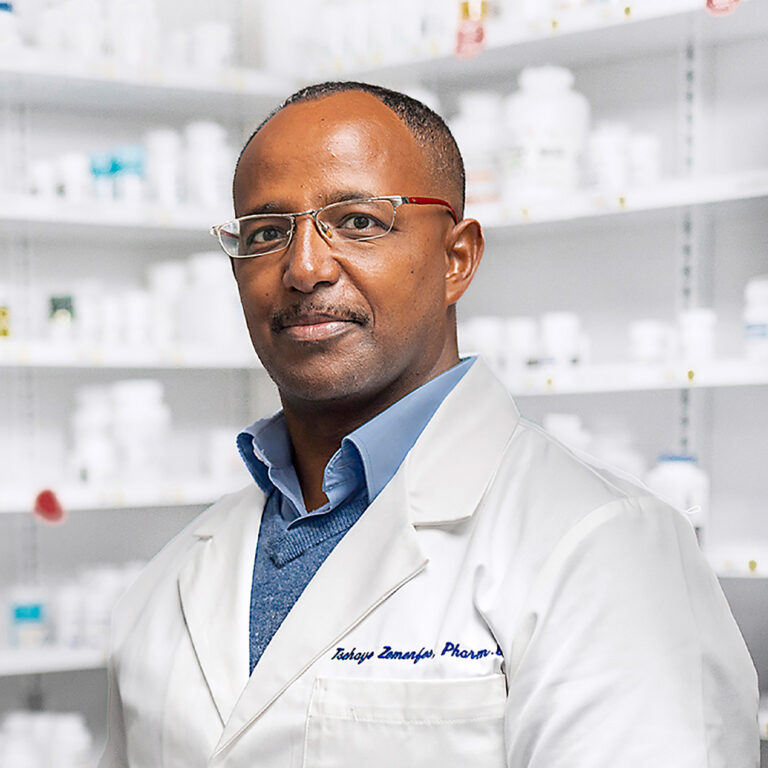2022 Winners

Education
- Master of Public Health from the University of Florida
- Doctor of Pharmacy from Nova Southeastern University in Davie, Florida
- Bachelor of Arts in International Development Studies from the University of Berkeley in California
Resume
- 8 years as director and clinical pharmacist at Alamo Navajo Health Center
- 2 years as an adjunct faculty member at Navajo Technical College
- 2 years as a pharmacy manager at Rite Aid in Washington, D.C.
Years in pharmacy
Tsehaye Zemenfes, Pharm.D., MPH, has been named Top Community Leader for his dedication to his patients and his extensive work in an isolated rural area as the pharmacist at Alamo Navajo Health Center in Alamo, New Mexico.
Originally from Ethiopia, Dr. Zemenfes has worked for more than eight years on Alamo’s Native American reservation, where he lives with his wife and children. “We live in a very isolated community,” he explains. “It’s a relatively small pharmacy that’s inside the building of the clinic.”
For Dr. Zemenfes, integrating into the community in which he works has been crucial, and not something his patients necessarily expected of him. “When I started, the first question I got was, ‘How long are you here for?’ In rural settings, there’s very high turnover,” he explains. “You will see providers and pharmacists come and go every three months or six months. It took me a while to understand that because of the high turnover, there’s a limited continuation of care.”
The COVID-19 pandemic posed several challenges for the team at Alamo Navajo Health Center, particularly because of their clinic’s isolation. “Being in a rural area is challenging,” Dr. Zemenfes says. “The next biggest town is one hour away.” While vaccination rollouts and COVID-19 treatments have helped, the pharmacist notes the importance of always “providing care despite the circumstances.”
The population faced additional difficulties due to financial constraints, which often had very serious consequences. “We have an impoverished community,” Dr. Zemenfes says. “Diabetes is high, patients often have comorbidities. We lost many and people are terrified.” With many families living in multi-generational homes on the reservation, isolation was often impossible. But by understanding the community, Dr. Zemenfes worked tirelessly to take care of every one of his patients, even during the most challenging moments.
Here, we speak with Dr. Zemenfes about the community he works in and how he provides for it.
What inspired you to become a pharmacist?
I’m originally from Ethiopia. I had an early encounter with a pharmacist. As a child, I used to get sick a lot, and I remember there was this particular pharmacist that my grandma took me to for medication. I remember how scared I was, but the pharmacist was very helpful. He encouraged me to take the medication. Back in the day, they used to make antibiotic capsules so big, and it tasted horrendous. But I remember how kind and encouraging he was. And after finishing the course of antibiotics, I felt better. That encounter inspired me to become a pharmacist.
What’s your typical work day like?
I work on a Native American reservation. The Indian Health Service is run by the federal government to provide services for Native Americans, but most of the decisions are made by local authorities or local boards. No two days are the same.
While I’m dispensing or counseling, if I notice a medication is missing, I’ll call the provider. If I can’t get ahold of the provider, I’ll offer to follow up on the patient’s behalf. Whatever issue needs to be addressed, whether it’s missing medication or a change of medication, we’ll always call our patients to update them so they feel that somebody cares and is working to address their problems.
On certain days, we are responsible for managing and administering COVID shots. I’m the chief pharmacist, so I also have administrative duties, besides clinical. And I’m the head of the clinic’s Pharmacy and Therapeutics Committee, promoting attainment of The Accreditation Association for Ambulatory Health Care standards.
How do you go above and beyond for your community?
Pharmacy is the most accessible health profession. Since the pharmacy is the last stop for the patient, it’s important to make sure that they have a good experience. Patients want somebody who listens to them and to feel like they’re heard. We always try to think, “If I was a patient, or if the patient was a family member, what would they need?” I emphasize this to my team, to take care of the patients, whatever their need is. We don’t just stop and say, “Oh, you don’t have a refill.” I try to operate from the mindset of, “We are helpful, not just somebody who wears a white coat, but a patient advocate.”
Since the pharmacy is the last stop for the patient, it’s important to make sure that they have a good experience.
I think our patients will say that I care. I’m there for them. I’m doing whatever it takes to make sure that their needs are met, as much as possible within my capacity. We are literally in a very remote place, which is not good for everybody. But I’m committed and I’m available and I’m willing to do whatever it takes to support the patient population here.
What advice would you give to someone pursuing a career in pharmacy?
Seek out different experiences because this is going to be your profession. This is going to be your life. Make sure you get the education that you want because you’re paying for it. Expose yourself to different parts of the profession. Think broadly, and make sure that you’re not single-minded, as pharmacy is more than retail.
You’re quite active on social media. What do you use your platform for?
I volunteer as an executive director for the Tegaru Disaster Relief Fund, which was founded in response to an increase in Tigrayan displacement from various parts of Ethiopia. We still have family in the northern part of Ethiopia, where there’s a civil war and genocide going on. Our families are cut off from the world. There’s no internet, no electricity, no banking services. Part of me giving back to where I come from is by trying to advocate for other people. The mission of the organization is to provide humanitarian aid and developmental systems, and we’re quite active in collaborating with other organizations to fund or implement projects.
As a pharmacist, why is it important to get involved in your community?
This is a small community, so you get to know the patients outside of work. When people see you walking, they stop by or honk and say hi. You just feel loved, and that you’re part of the community. In rural areas, there’s a high turnover of healthcare providers. I have been here for over eight years, so patients know I’m committed and not just here to do a job.
I’m committed and I’m available and I’m willing to do whatever it takes to support the patient population here.
When people accept you being part of the community, they open up to you, and you have a good understanding of what they’re going through. My children go to school here. My wife’s organization is here. We have a vested interest in the community.
What does this award mean to you?
I’m honored that I am a winner. In the past, I think pharmacists have just quietly done their jobs because it is a very satisfying, gratifying profession. But being recognized is important because it’s one way for the public to know the important contributions pharmacists make and to see the extraordinary work that we’re doing in different sectors. Pharmacists are going above and beyond to support their patients and to provide care. It’s important for people to see that.

